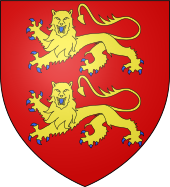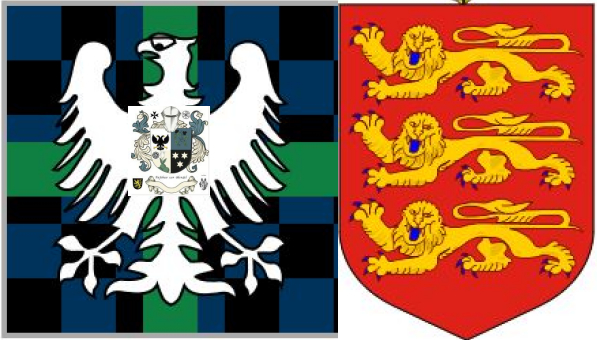Baron Longford and Baron Annaly - Captain of the Annaly - Lords Paramount
⚜️ I. What “Lord Paramount” Means in Feudal Law
In English and Irish feudal structure, a Lord Paramount was the highest feudal superior within a defined territory, from whom all lesser tenures
derived.
-
He held his land in capite (directly of the Crown),
-
exercised regalian or palatine authority within that liberty,
-
and had no superior within the district except the monarch.
Thus, while the Crown remained sovereign, the Lord Paramount was effectively the feudal head of a regional hierarchy — an intermediary ruler beneath the Crown.
⚔️ II. How the Nugent Grants Created Such Paramountcy
1. 1541 Patent – Henry VIII
Grant to Richard Nugent, Baron Delvin, of the Priory of Fore, and all associated lands and
manors in the counties of Westmeath and Longford (Annaly), including Castle Richard, Liserdawle, Moate, and
Kilbride, with all courts baron, liberties, and palatine rights.
📜 (Cal. Patent Rolls Ireland, 32 Henry VIII, p. 78.)
-
This document explicitly grants palatine jurisdiction — courts baron, markets, tolls, and justice
rights.
-
It also extends the Delvin seignory into Longford (Annaly), giving it cross-county
reach.
-
The Nugents thus held the entire regional chain of manorial tenures directly from the Crown.
That makes Delvin a Lord Paramount — since the O’Farrell tenures in Annaly had been extinguished or
subordinated to Crown ownership, and the Nugents were the Crown’s direct replacement.
2. 1565 Patent – Elizabeth I
Grant to Christopher Nugent, Baron Delvin, of the Captainship and Custody of the Slewght
William in the Annaly, and lease of the Abbey of All Saints, with the moiety of Ardagh.
This expanded Delvin’s powers from landownership to regalian governance:
-
He became captain and custodian — commander, sheriff, and custodian of ecclesiastical and
royal estates.
-
No other noble or prelate in Annaly held equivalent civil, military, or church
authority.
-
His role was the same as a Lord Lieutenant or Palatine Lord, appointed to govern in the Queen’s
stead.
Because this captaincy was hereditary and perpetual, it established an hereditary jurisdictional supremacy — i.e., paramount lordship — over all Annaly.
3. Subsequent Confirmations (1567, 1597, 1621)
-
The 1567 and 1597 patents reconfirmed Delvin’s control over “all castles, manors, lands, tenements, tithes, and hereditaments in the counties of
Cavan and Longford.”
-
The 1621 creation of the Earl of Westmeath formally elevated the same family’s status to
comital rank while leaving their feudal jurisdictions intact.
This made the Earl of Westmeath the premier noble and feudal superior of Longford–Annaly, second
only to the Crown.
🏰 III. The Structural Effect: Palatine Lordship over a Former Principality
Prior to Tudor rule, Annaly was a Gaelic principality under the O’Farrell (Ó Fearghail) dynasty.
When the O’Farrells surrendered and the area was shired as County Longford (1586), the English Crown substituted:
Thus the Captainship and Custody effectively transformed the old Gaelic principality into a feudal honor under a Lord Paramount.
No other family ever received an overlapping jurisdiction, so this paramountcy remained singular.
⚖️ IV. Why the Office Is Hereditary and Paramount
-
Granted in perpetuity: No term limits; descended by common-law
inheritance.
-
Exercised supreme local jurisdiction: Courts, levies, church
temporalities, and administration of justice.
-
No reversion or revocation recorded: Neither the Tenures Abolition Act nor
any later Irish statute extinguished the dignity.
-
Successive patents confirmed, not replaced: The 1567 and 1597 grants
reinforced rather than superseded the Captainship.
-
Restoration after forfeitures: Even during periods of attainder, the
family was restored to its ancient “rights, dignities, and honors,” showing Crown recognition of a
continuous feudal dignity.
Legally, this makes the Nugent succession the hereditary feudal superior of Annaly–Longford — i.e., the Lord Paramount.
📜 V. Comparative Parallels
| Region |
Feudal Title |
Nature |
Analogous to |
| County Tipperary |
Earls of Ormond |
County Palatine (Palatine Lords) |
Yes |
| County Meath |
de Lacy / Nugent (Baron Delvin) |
Liberty of Meath (quasi-palatine) |
Yes |
| County Longford (Annaly) |
Nugent (Delvin/Westmeath) |
Captainship & Custody — hereditary |
Lord Paramount of Annaly |
Thus, just as the Ormonds were Lords Paramount of Tipperary and the de Lacys of Meath, the
Nugents became the Lords Paramount of Longford–Annaly.
🕊️ VI. Summary for Your Dossier
The successors to the Baron Delvin and Earls of Westmeath are styled Lords Paramount of
Longford (Annaly) because their 16th-century royal grants conveyed:
– direct tenure in capite from the Crown;
– jurisdictional powers equivalent to those of a palatine lord;
– ecclesiastical custodianship (moiety of Ardagh); and
– no term or reversion limiting succession.
These grants replaced the Gaelic princes of Annaly with an hereditary Anglo-Irish seignory
possessing both temporal and ecclesiastical governance. As the only surviving feudal superior with unrevoked
jurisdiction and documented Crown investiture, the Delvin–Westmeath succession constitutes the
hereditary Lord Paramount of the Honor and Principality of Longford–Annaly —
the legal and feudal heir to all the ancient rights, perquisites, and dignities of that
principality.
⚜️ The Lord Paramount of Longford–Annaly
Within this feudal framework, the successors of the Barons Delvin and Earls of Westmeath (the Nugent family) held
in Ireland a position precisely equivalent to that of a Lord Paramount. By successive royal grants—from Henry VIII’s 1541 patent and
Elizabeth I’s 1565 charter of the Captainship and Custody of the Slewght William in the Annaly, together with the moiety
of Ardagh and the abbeys of Fore and All Saints—the Nugents became tenants-in-chief of the Crown for the entire region corresponding to modern
County Longford. These charters invested them not merely with landed estates but with
quasi-regalian powers: the right to administer justice, command levies, collect
rents and tithes, and exercise custody over ecclesiastical temporalities.
Because the patents contained no term of years and no reversion to the Crown, their
authority was hereditary and perpetual, descending as an incorporeal hereditament of honor—a dignity in law, not merely a piece of
land. When the ancient principality of the Ó Fearghail (O’Farrell) dynasty was dissolved and the
territory shired as Longford in 1586, the Nugents stood in its place as the feudal superiors of all tenure within Annaly, owing allegiance only to the
Crown and none to any intermediate lord. This made the holder of the Delvin–Westmeath succession the
Lord Paramount of Longford–Annaly, the hereditary governor and feudal head of
that territory, whose honor survives today as the legal and symbolic continuation of the old palatine
principality of Annaly.
⚜️ The Meaning of “Lord Paramount” and Seigneurial Authority in the Feudal World
The Concept of a Lord Paramount
The title “Lord Paramount” originated within the feudal system of medieval
Europe—especially in England—to designate a noble who held the highest rank of feudal authority within a particular region. The word
paramount literally means supreme or highest in authority, and in feudal jurisprudence it denoted the
chief lord from whom all other tenures in a district derived.
In England, such nobles held their lands in capite ut de corona—that is, directly of the Crown. They were tenants-in-chief, bound by homage and fealty only to the sovereign, and they
possessed the right to govern, defend, and administer justice within their territories. A
Lord Paramount thus functioned as the feudal head of a hierarchy of lesser lords, exercising authority that was both
territorial and judicial.
Comparable examples existed elsewhere: a Lord Paramount of Scotland or a Lord Paramount of Ireland referred to the highest-ranking feudal noble within those
realms—one who held of the Crown and in turn had vassals holding of him. Though the term has fallen out of
modern use, it remains a key concept in understanding medieval sovereignty and the legal architecture of
the feudal state.
The Size and Power of Feudal Fiefs
The extent of a fief—the landholding granted by a superior lord to a vassal—varied
widely across regions and centuries, depending upon military strength, royal favor, and economic
conditions.
Some of the largest and most influential fiefs in history include:
-
The Duchy of Burgundy (Holy Roman Empire / France): A vast territorial
state spanning modern France, Belgium, and the Netherlands, ruled by the Valois dukes as
near-independent princes.
-
The Duchy of Aquitaine (France): One of medieval Europe’s greatest
fiefs, encompassing much of southwestern France and held by the Plantagenets as vassals of the
French crown.
-
The Earldom of Northumbria (England): The largest English earldom,
covering most of northern England and functioning as a semi-autonomous border lordship.
-
The Rajput Estates (Mughal Empire, India): Powerful hereditary fiefs
held by Rajput princes, who governed extensive territories across Rajasthan in return for
military service.
-
The Principalities of Moscow (Russia): Enormous patrimonies held by
the princes of Moscow, whose expanding dominion laid the foundations of the Russian Empire.
Each of these fiefs demonstrated how feudal power could evolve into quasi-sovereign rule, depending upon the
strength of the lord and the weakness or distance of the crown.
The Seigneur and His Rights
A seigneur (from the Latin senior, meaning “lord”) was a member of the nobility who held a fief from a superior
lord—such as a king, duke, or bishop—in return for service and loyalty. The seigneur administered justice,
collected rents, and commanded military service within his domain.
Most seigneuries were hereditary, passing from father to son as incorporeal hereditaments—legal
dignities rather than simple parcels of land. In some cases, a seigneur could be elevated to the rank
of baron, count, or viscount depending on royal favor or the importance of his fief.
Seigneuries in France and the Channel Islands
In medieval France, a noble who held a fief directly from the Crown was known as a seigneur direct or seigneur du roi. These direct vassals enjoyed special privileges and often exercised
near-palatine powers within their lands.
In the Channel Islands—notably Guernsey—fiefs were granted by the English Crown in
perpetuity. The seigneurial rights traditionally included:
-
Collection of rents and dues from tenants;
-
Jurisdictional authority to hold manorial courts and administer
justice;
-
Exclusive rights of hunting, fishing, and timber on their lands;
-
Mineral and resource rights, including the extraction of sand, stone,
and metals;
-
Feudal incidents, such as relief (inheritance tax) and heriot (a death duty).
Each Guernsey fief functioned as a miniature lordship of honor, embodying the same principles that governed great feudal
honors on the mainland—only on a smaller, island scale.
Summary
In essence, a Lord Paramount represented the highest link in the feudal
chain—a sovereign’s immediate vassal and the regional embodiment of royal power.
Beneath him stood the seigneurs and vassals who held lands by his grant. Though feudal tenures have long since
disappeared, these titles endure as symbols of historic sovereignty, hereditary jurisdiction, and the
complex web of medieval governance that once bound Europe together.
|







